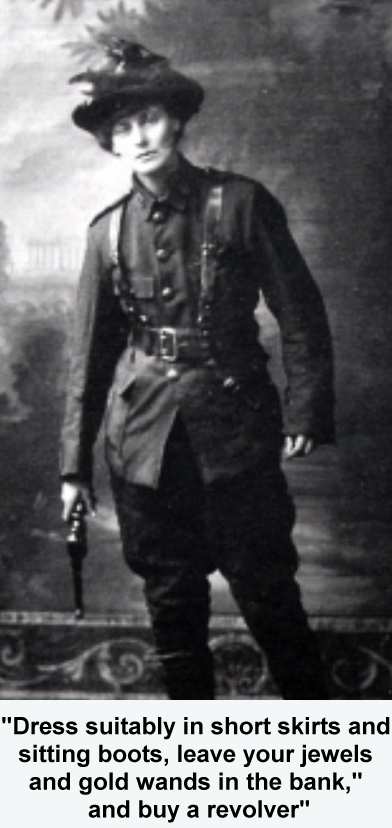Of the many stories of revolutionaries that emerged from the early
part of the twentieth century in Ireland one of the most remarkable
involves the woman who was born Constance Gore-Booth in 1868.

She was born in London to Sir Henry Gore-Booth,
the famous arctic explorer, who was an Anglo-Irish
landlord. Her father was not typical of his type
and administered his lands with a degree of
compassion for the peasantry who farmed it.
Such was his mercy that he is reported to have provided famine relief at
his estate in Sligo during the famine of 1879.
This act undoubtedly inspired
humanity and concern for the poor in his daughter.
Living in Sligo the family were friends with the
family of W.B. Yeats, the romantic Irish poet.
He later wrote the poem 'In Memory Of Eva
Gore-Booth and Con Markievicz'.
The young Constance initially studied painting in London in
1893 where she became involved in the issue of
suffrage for women, joining the 'National Union
of Women's Suffrage Societies'. She continued her
artistic studies in Paris in 1898 where she met
Count Markiewicz, who was a Ukrainian aristocrat
of Polish origin. They wed in 1901 after which she
assumed the title Countess Markievicz. The couple
settled in Dublin in 1903 where the Countess
co-founded the 'United Artists Club' which was a
cultural and artistic organization. It was perhaps
inevitable that while circulating in such society
she would be exposed to the revolutionary ideas
that were being swept along with the Gaelic
revival of the time.
In 1908 she joined Sinn Fein
and Inghinidhe na hEireann - 'The Daughters of
Ireland', which was a revolutionary group
established by Maud Gonne, with whom she later
acted at the fledgling Abbey Theatre. She
continued to participate in the Suffragette
movement in England and by standing for election
she helped to defeat Winston Churchill in a 1908
Manchester by-election.
It was in 1909 that she established the radical 'Fianna
Eireann' which was aimed at instructing a youth
army in the use of firearms. She was jailed by the
British authorities in 1913 after speaking at an
IRB rally to protest the visit of George V to
Dublin. She had also joined the Irish Citizen Army
(ICA) established by James Connolly in response to
the 1913 'lockout' of workers. She established soup
kitchens and aid for the Dublin poor, often using
her own funds. Her marriage had by now
disintegrated with her husband returning to Europe
in 1913.
The Countess became a Lieutenant in the ICA and participated in the Easter Rising of 1916 where she
was second-in-command at the fight on St. Stephens
Green. Initially the rebels dug trenches in the
green but soon retreated from this position once
they were became vulnerable to snipers positioned
on the high buildings around the enclosed green.
Under the command of fellow ICA member Michael
Mallin they occupied the Royal College of Surgeons,
rebelling for a total of 6 days. They surrendered
only when they received a copy of Padraig Pearse's
surrender order.

The Countess was jailed in
Kilmainham and sentenced to death but her sentence
was commuted on grounds of her gender. 'I do wish
your lot had the decency to shoot me' she retorted.
She was released from prison in 1917 by which time
the tide of support had turned in favour of the
rebels and the path to independence was set.
In 1918 she was again jailed for her
anti-conscription campaigning but upon release was
elected to the English parliament, refusing to
take her seat. She was the first woman to be
elected to the House of Commons. She was a member
of the first 'Dail' (Irish Parliament) in 1919 and
became the first Irish (and indeed European)
Cabinet Minister, serving as Minister for Labour
from 1919 to 1922.
Countess Markievicz joined deValera in opposition to the
Anglo-Irish Treaty of 1922 which partitioned the
country and fought in Dublin in the ensuing civil
war. She was again imprisoned but this time by her
former comrades-in-arms. Upon her release she
became a founder member of Fianna Fail and was
elected to the fifth Dail in 1927. deValera had by
this time changed tactics and intended to
participate in the parliament.
The Countess
however, never got her chance when, at the age of
59, she died of tuberculosis (or possibly
appendicitis) in July of 1927. She likely caught
the disease while working in the Dublin slums.
Her husband and family were by her side.
The famous Rebel Countess was buried in Glasnevin Cemetery with a
huge farewell crowd of 300,000 in attendance at the north Dublin graveyard, the final
resting place of so many of Ireland's great patriots.

 She was born in London to Sir Henry Gore-Booth,
the famous arctic explorer, who was an Anglo-Irish
landlord. Her father was not typical of his type
and administered his lands with a degree of
compassion for the peasantry who farmed it.
She was born in London to Sir Henry Gore-Booth,
the famous arctic explorer, who was an Anglo-Irish
landlord. Her father was not typical of his type
and administered his lands with a degree of
compassion for the peasantry who farmed it.
 The Countess was jailed in
Kilmainham and sentenced to death but her sentence
was commuted on grounds of her gender. 'I do wish
your lot had the decency to shoot me' she retorted.
She was released from prison in 1917 by which time
the tide of support had turned in favour of the
rebels and the path to independence was set.
The Countess was jailed in
Kilmainham and sentenced to death but her sentence
was commuted on grounds of her gender. 'I do wish
your lot had the decency to shoot me' she retorted.
She was released from prison in 1917 by which time
the tide of support had turned in favour of the
rebels and the path to independence was set.
